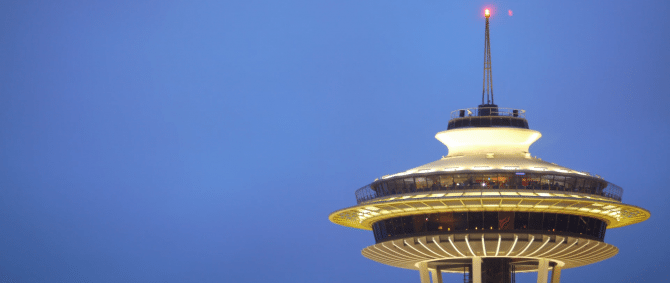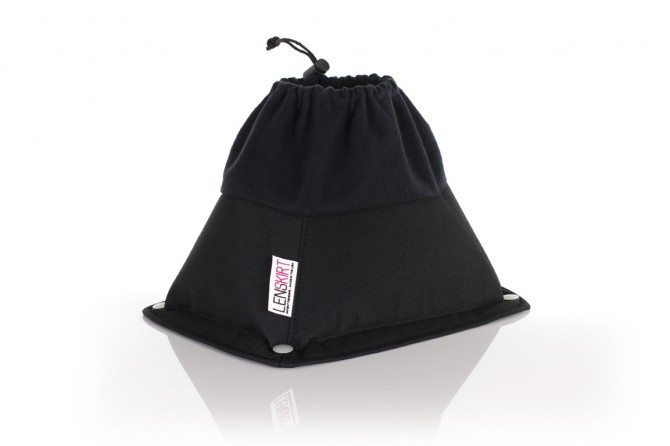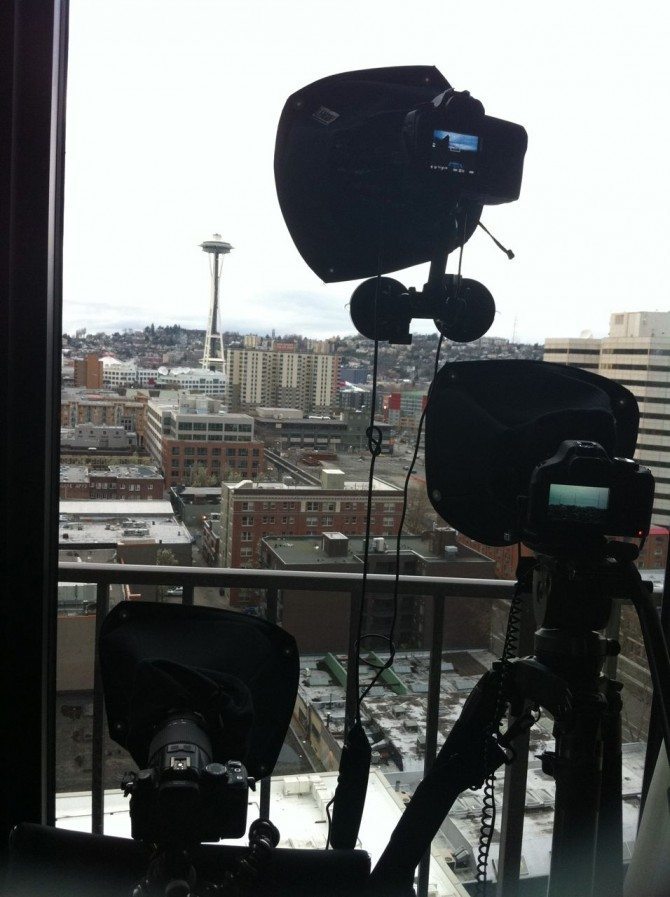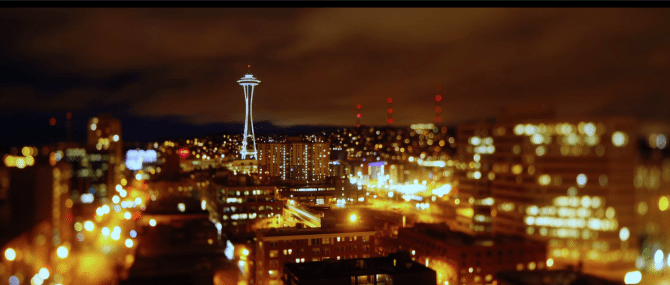
I had actually given up doing Timelapses from hotels rooms after my year long project “A Room With A View” finished around October last year. The results were fun but the constant clicking at night certainly was not!! It was lovely to have peace and quiet again! Then on my last night in Australia in February I stayed in a hotel with a magnificent view of the Sydney Harbour. I made a film of that called 3513.
I write this in my hotel room in San Francisco which has to be honest a very uninspiring view. In fact most of the hotels I have stayed at in the past 4 weeks on the CanonFilmmakers Live tour around the US have been pretty crappy. So crappy in fact when I opened my first curtains in Chicago and had Wallgreens out front I decided to do timelapses of every hotel view I stayed in on the tour no matter how crappy it was. To see if you can make something out of very little and I will at the end of the trip.
Of course when I got to Seattle that changed! We got an upgraded room at the Warwick Hotel and asked for a view of the Space Needle. It was superb.
Now I am a very creative person and I need to let my creative juices flow and doing this month long workshop tour has meant I have done little if anything creative in the past month. So I vowed, with 2 days of Seattle to make something of this very interesting view using my 5Dmk2, T2i, T3i and GH2. I really adore teaching but I still prefer to shoot.
What was key was mains power supplies for the cameras (I don’t have one for the Gh2) and the lensskirt which blocks out reflections from the room’s windows. The Delkin suction mount is a great piece of kit too for doing timelapses through windows. Very strong and sturdy.
 You can see more of my setup in this video below:
You can see more of my setup in this video below:
Timelapse of Seattle Space Needle Set-up from Philip Bloom extras on Vimeo.


So here is the video below and below that is a 21 minute commentary going into a lot more depth about the shoot, the what, the how and the why. Let both the video and commentary load up and only press play on video once I say so in the commentary track and when I say pause…pause it! There really is a ton of information in the video including my thought process on music and the issues how have.
One thing I have been told is the Space Needle is a trade mark so I could not use this footage of it commercially without permission. Very interesting that and I need to investigate further…
This is personal piece of work and it’s what I love to make. No client, no broadcasters, no demands. Made by me for me. This is what makes me happy. Making something like this and of course sharing with you my thought process that I had whilst making it…
Graded in Magic Bullet Looks: 20% off at RedGiantsoftware.com with code bloom20 at checkout.
The Space Needle from Philip Bloom on Vimeo.
Commentary: The Space Needle by PhilipBloom

62 comments
Philip, two questions:
1. why don’t you choose to shoot RAW when doing timelapses?
I find that it gives you so much more to play with when you open them up in Photoshop RAW, in terms of corrections for color temperature, tint, etc.
2. why don’t you process the images in After Effects?
After processing, if you open up the first RAW (5000×3000 pixel) image as a sequence in After Effects, you have so much more to play with in terms of effects that you can add.
Honestly, try it, you’ll love it…
Since AE handles digital files differently than most NLEs do, you’ll find that you won’t get bogged down that easily with out-of-memory notifications on your Mac. Also CS5 is fully 64-bit so it uses all of your cores, compared to the 4GB that you can use at the most with FCP…
Richard, I took over 150,000 stills. The amount of storage for RAW would have been ridiculous for this project.
150.000 stills indeed is a lot… for a smaller project you might try it, though…
BTW, the results are spectacular, as always…
Richard, you can import RAW files directly into an AFX image sequence…?? I’ve processed at least a million timelapse images by finalizing the image in Lightroom (or Camera RAW before that) and exporting the JPEGs, importing those into AFX and proceeding.
Since AFX can access 14-bit (and 32-bit) image data, I guess that this is possible, but wouldn’t you rather have the Lightroom noise reduction, graduated filter and spot brush tools available?
beautiful as always ! thank you Philip !
would LOVE to know the names of those suction devices used..
thanks mr bloom
They are called Lens Skirts, seems I’m gonna need at least one of these just in case. for fish tanks it seems to be a must!
http://frankglencairn.wordpress.com/2010/12/28/letus-releases-nifty-lensskirt/
@Algerson Check out the set up vid. http://vimeo.com/21786367
Think Philly G. mentions that they’re Delkin suction mounts.
Not just saying this to be nice, you do awesome work. The finished footage looks absolutely flawless.
Phillip, I was a 4 year student in a prestigious film school program and I can honestly say this 20 minute commentary was probably better and more educational than anything I experienced there. The old saying “those who can’t, teach” certainly doesn’t apply to you. You can and you teach.
Not to piss off my brethren here, but have you considered an online model which I know has well served others? Make your content free for a week, but make the archives subscription based.
Either way, I hope you’re around for a long, long time. Congrats on the film, and thanks for the illumination – both literal, and figurative.
Really kind comment Greg. Sorry for late reply. Appreciate it!
Did the sun ever come out?
Very nice work. I feel I learn a little something every time. Plus I get to keep my math skills sharp when logging in. 😉
Wicked work again mate, quick question, how did you push in if you weren’t shooting RAW
Large JPEG is still 5K!!
Loved it Phil – had a really different and cool vibe to it.
Your use of Tilt shift is fucking delicious!
great commentary – seemed more in-depth than usual from a post point which was excellent. ( Good note about the music at the end also + no need to flirt with Uranus…..)
With your epic amount of footage / size of files – are you just rocking an external 1TB lacie around with you or ?
bit of NAB Vegas timelapse perhaps ?? 🙂
Cheers
seb
You mention in your commentary that on day to night time-lapses you adjust the “night” color in Magic Bullet Looks (as you’ve set WB at 5600K). How exactly do you do that? Do you “cross fade” between two video tracks of the same shot, each with it’s own color? Many thanks. I don’t think you’ve ever addressed this issue previously…
i do two slices, change temperature in middle then add two long dissolves
Lovely images. The compositions and grading are superb.
The GH2 shot seems to show a great deal of posterization when compared to the Canons. Vimeo compression notwithstanding, are you finding noticeable posterization in your original images?
Glad you enjoyed yourself in our fair city.
Philip,
Do you have to change shutter speed, iso, wb when transitioning from day to night or is it all the same?
is your exposure time around 3 seconds per photo? do you use an nd filter? interval lengths always around 10 seconds?
i know you stay at 5600 k during the daytime, at what point do u change to like 3600 or whatever, for shooting at night.. thanks.
Evan
awesome! Thanks for doing the commentary
love the zoom shot @ 2:07, it fits perfect with the music
I second Richard’s comment about using AE for still image sequences, it’s a much more flexible environment. I didn’t realize you were in Seattle, I’d have bought you a drink! Maybe next time…
Hi Philip,
Nice job !
I have a question : How do you avoid dust on dirty windows generally existing on such hotels buildings ?
Very, very nice (again)! Thank you for the commentary.
Just wondering which light metering mode did you use on the cameras: average, spot, evaluative?
And why is live view turned on?
What kind of storage do you use? One or multiple harddisks? RAID?
BY coincidence I was trawling my movies folder last night and watched “EX1 Letus 720p” (that’s what the file’s called on my system, it’s the one with ‘Venus in Furs’) just before you posted this.
Amazing what’s the same and what’s different in a few short years. Thanks for showing us so much.
It turned out very good Philip, the first shot of the needle with the office windows turning on and the digital pull in was in my view the treat, followed by the Queen Anne hill with the homes and antennas.
150k frames, OMG I bet those shutters are wearing out daily. Have you sent any for repairs yet?
In any case it was a great piece thanks for sharing and the commentary, the setup was epic!
Hi Philip,
I love time-lapse! I have a question, I attended CFLive in Austin and you mentioned slightly disconnecting or taping the lens contacts to avoid flicker from the aperture not being right on each time, I tried this but my camera often (though not always) gives a communication error. What is the trick to avoiding that error and locking the aperture in place (besides using manual aperture lenses)?
Thanks!
That post was a ton of work. Great info and insight.
I liked how you slowly worked your way out to the Space Needle.
great pacing, starting with one small drop, setting the mood.
Great pieces always have surprises, water drops, mountains, all
from a simple hotel room window. Too bad the Olympic mountains to the west
were not visible, they are beautiful.
Thanks for the hard work, I enjoyed it.
LT
thanks Larry!
Very nice work. That last shot with the lights through the rain drops was especially captivating for me. Really beautiful. Makes me want to go out and shoot with my new GH2, even thought I don’t have an editing system that can handle AVCHD yet.
I noticed your apertures are rather wide open (f/4, f/2.8, etc). What’s the primary reason you choose this? Since your shots seem more landscape/environment in composition, wouldn’t smaller f-stops (8,11,16) be more appropriate to get greater, sharp depth of field from front to back? In addition to that, the slower shutter speeds would also smooth out some of the animations. Thanks.
hi brian
to get through the dirty windows and wide open on tilt shift accentuates the effect and wide open full stop reduces flicker….
Please. A bit more info on the Mains power supply? Appreciate it.
i just bought it from amazon…
Love the whole thing, but the first few and last few shots sell it for me. Rain on the window with colored lights blurred into geometric shapes… that’s how I think of my hometown, too. Great work.
I figured it out! It seems I was disengaging the lens a little too far, I experimented with it in different locations and found just the right spot that it won’t error.
Hi,
I went to the London protests to film a music video for one of my anti-banker songs and came up with the idea of using my Bell & howell anamorphic lens which I use to watch movies with a DLP projector on my Canon A540 pocket camera. I fashioned an attachment using some steel sheet folded in work and a jubilee clip. This odd couple was then clamped to a tripod with an ankle weight strapped to the bottom as a steadicam. I’ve never made a video before or used editing software so it may look a bit amateur but I was pleasantly suprised. I think we can do much better next time. It only films in 640×480 but has a fair amount of detail in it’s cinemascope aspect.
you can watch it here
http://www.youtube.com/watch?v=OjPJ45kmDz8
The lens was a bargain off ebay and the total price for camera, lens, tripod, ankle weight was about £120 which I’m sure is a cheap way into the movie business!
hope you like it as much as enjoyed making it.
Great film, thanks for the commentary as well. Just wondering how you avoid minor light variations in Av while shooting during the day with your timelapses. I’ve had some issues with “flickering” as the metering changes as clouds get lighter and darker.
You mentioned using Kelvin white balance on all cameras, are you using magic lantern software at all with the t2i?
fucking brilliant. – this is why I subscribed to your site philip – those commentaries are so helpful. You must know how great it can be to shadow someone who really knows what they’re doing, and in a way thats what those commentaries can do to the people who really want to listen and learn something. I personally take note with everything you say in them and I cant tell you how much I appreciate you giving your time to explain.
-devin
thanks devin
Love the work as always Philip.. Just wish i could find the flippin’ secret to getting my intervalometer to actually fire the shutter on my 5D mkII.. plug and play is now plug and pray..
why is it doing that?
All above questions answered at his Canon Filmmakers Tour. I attended the SF sess yesterday. It’s worth the buck fiffy
Really nice as usual Philip. That Long Exposure Plugin… does it do the same thing as a motion blur effect?
Haven’t done much timelapse yet, but I did figure out that After Effects copes WAY BETTER with large res stills – very quick and stable. I’ve been building the sequences in AE and exporting as video files for editing & grading in premiere CS5 – seems to work nicely.
As for using RAW files… agreed – insanity!
Great Work Phil, thanks for the commentary its always a great insight into BTS.. wish i could hop in your luggage and see the sights u see….
thanks again…
dave.
Absolutely beautiful! I’m amazed at your sensitivity to motion, story, light, drama – all those things that you have to sense in your head before you can see the whole. Awesome work. Definitely the best (imho) in this genre.
One Question: how did you remove the flicker?
I didn’t have any Jon. Thanks for comment appreciate it! Shooting wide open helps remove flicker!
oh, ok, so the aperture may be the source of a lot of flicker. I tried an old manual Nikon lens and voila – no flicker (manual shutter). But how do you get an EF-S lens to behave like a manual one? I tried tape on the lens contacts and that did the trick but had to shoot wide open. So I Googled it and came up with this brilliant idea from Anthony Powell on timescapes.org:
—-
1 Turn camera on and select the aperture setting you want
2 Hold down the depth of field preview button
3 While holding down the button hold down the lens release button and rotate the lens about 6mm or 1/4 inch. This should be just enough to disengage the lens contacts, while still having the lens held firmly in place without the locking pin engaged.
The camera will now treat the lens like a manual lens, and will allow you to keep whatever aperture setting you want. It will also prevent iris wear, and remove the need to switch to manual focus, saving wear on the AF/MF switch.
!!! Be careful to snap the lens back into place once you are done so it does not fall off at an inopportune moment later on while you are carrying the camera about !!!
—-
working on a test now…
2.26 looks like Bespin from The Empire Strikes Back, nice.
thanks Stuart!
Hi Philip, great timelapse sequence! Looks beautiful.
We recently used long exposure timelapse sequences as a narrative tool in a short film. We were lucky enough to be featured on staff picks for vimeo and I got best cinematography at the worlds largest short film fest.
I have pestered you on twitter but you probably get bombarded there, I would like your opinion on our film as this was my first real job involving timelapse.
http://vimeo.com/20230217
good shooting and best regards
tony gardiner
i forgot to mention i was interviewed by mike seymore (with jason wingrove) for the RCpodcast #83 about the project if anyone would like more info on how we achieved the look of this film
Hey Bloomy baby,
I was just spamming my video from a google search and had never paid any attention to DSLR movie making. I’ve been checking it out now though and it sure is nice. The colours take me back to using slide film.
So there I am on youtube looking at these lovely but souless clips of flowers and dragonflies and I see your name, it was a film about Venice beach I think.
Now that’s more like it, a bit of real(human)life. That was great dude. The Vietnam vet was a slight cope out, more of angry drunk dude and his mate would’ve been good, you’re a big guy you could’ve fought him off 🙂
I have a newbie question: What do you think about the 550D? I fancy an upgrade from my a540 and I can’t see anything worth buying other than a half decent DSLR for video. Are there any cheaper than the 550D or is that a minimum in terms of quality and manual control? I fancy making a ZBDS movie but that’s gonna involve some decent light to get the a540 odd couple to give a decent picture but with a DSLR would I be able to get away with not so much bright lights to light a person/scene?
Thanks bro, my eyes are now slightly more open
Thanks for opening my eyes bro
As a 5d shooter I appreciate your commentary, amazing work (when do you sleep?). Beautiful aesthetic.
More importantly, as a Seattleite, this is a lovely homage to the Space Needle at 50 (and helpfully maintains the myth about Seattle that it always is grey and rainy!).
The audio commentary was really informative! Thanks for taking the time to do that!
it won’t let me color grade in magic bullet looks when the file size is so huge. Largest still size using 5d mk ii… How do you go about this?
export from the sequence as a reference file the shot you want to grade then bring it back in. thats what i did
Well, aside from a very catchy site that you have, i like more the video a lot! how did you do it? like acurtains in Chicago that creates excellent angles of moves, you also made an excellent shot with your video! Pretty cool!
Simply beautiful. So stoked to find another time lapse + commentary post! Now off to hopefully find some more! Oh and also donated to your movember cause today. Wicked to see such a blatant plug of a good cause with fantastic motivation ( Could really do with a rode mic /and / or viewfinder for my 7D! viewfinder 1st choice).
I’m also considering joining your timelapse movember thing… had a beard but this might be the perfect excuse for a big dirty handle bar mo!
Nice work, with very informative commentary. Considering all the image sequences you have to sort through, it must take a lot of time to match things up to the music. James Newton Howard is a great choice. As one who lives in Seattle, you have made our dreary weather look more interesting than I usually view it! Please come back in the summer, when the available light is so much nicer.